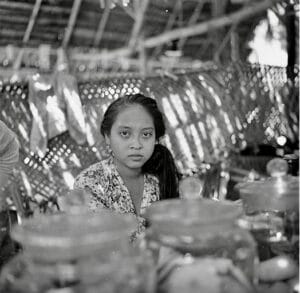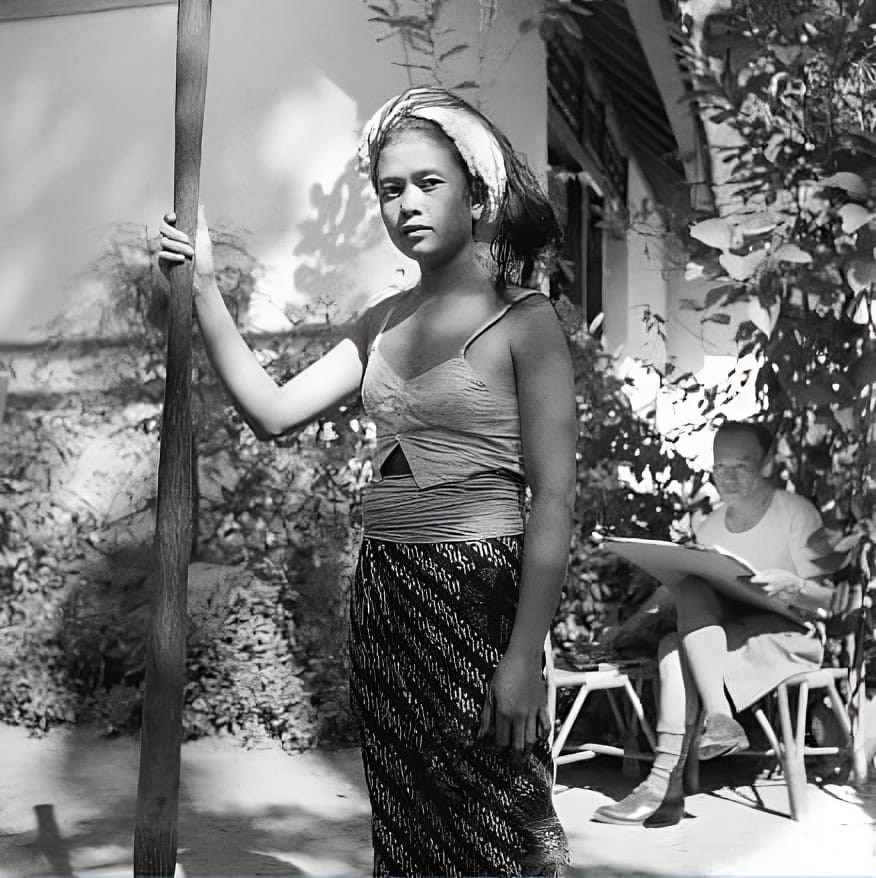Bali 1952: Through the Lens of Liu Kang documents a seven-week trip to Java and Bali in 1952 by four China-born and Shanghai-trained Singapore artists—Chen Wen Hsi, Chen Chong Swee, Cheong Soo Pieng and Liu Kang—to sketch and paint tropical beauty.
The book is compiled from the archives of Liu Kang (1911–2004)—letters and a diary, but also many hundreds of his photographs, which came to light only in 2016 when the author, Liu Kang’s daughter-in-law, found the negatives and prints neatly stored in the late artist’s study. The short-term result of the trip was artworks for an exhibition in Singapore the following year. Yet there was hidden treasure in the photographs, which show glimpses of Java and Bali at a time when there were very few visitors to Indonesia.
The photographs are uncropped and framed with a fine eye.

In 1952, the Republic of Indonesia was only two years old, and it was battered by years of war and revolutionary struggle. The people were poor. There was political unrest. After seven decades of development and tourism, Java and Bali look different now. Liu Kang’s photographs, published here for the first time, record landscapes, architecture and scenes of daily life from an obscure time in Indonesian history, observed by a visiting artist.
The book is a collaboration between the National Library Singapore and Gretchen Liu, a writer and independent scholar of Singaporean culture, history and architecture. It is at once a devotional labour and a joyful work of scholarship. The text recounts the journey clearly and in detail. The photographs are uncropped and framed with a fine eye, and they carry the narrative with informative captions.
Gretchen Liu explains the trip in the context of the Singapore art scene:
Today, the four protagonists are hailed as Singapore’s pioneering artists, a label that emerged in the early 1980s after a series of major one-man retrospectives, presented at the National Museum Art Gallery, Singapore’s first national art gallery. But as they were packing their bags for Indonesia, they were struggling. Life was tough. Official infrastructure for art appreciation was non-existent; there were no galleries and few buyers. Artists showed their works at exhibitions organised by the Society of Chinese Artists, established in 1935, and the Singapore Art Society, founded in To make a living, the four taught in Chinese middle schools and the Nanyang Academy of Fine Arts, which had opened in 1937. It was less than ideal.
Their destination was Bali.
Although they spent a week in Java, their destination was Bali. The four artists were lured to Bali because of its fame among travellers in the 1920s and ’30s who recorded their enchantment in books, photographs, and films. Moreover, Liu Kang had been a student in Paris during the sensational Exposition Coloniale de Paris in 1931, when a Balinese dance troupe took the city by storm. In her discussion why Bali attracted the artists, Gretchen Liu uncovers a nugget of interesting coincidence: the Mexican artist Miguel Covarrubias—whose Island of Bali (1937) remains a classic ethnography of Bali—was well-known in Shanghai art circles. Covarrubias visited Shanghai in 1930 and 1933 on his way to Bali.
On his second trip, he met with a number of Chinese artists who were familiar with his work published in the magazine Vanity Fair. […] A double-page feature on Bali torn out of Syonan Gaho, the illustrated magazine in English and Chinese published in Singapore during the Japanese Occupation from 1942 to 1945, was found in Liu Kang’s study. Titled “Bali in the Greater East Asia Prosperity Sphere, its dance, opera and others”, it clearly features the drawings of Covarrubias—but nowhere does his name appear.
From the very beginning of their travels, the artists were helped by friends in the Chinese diaspora, sometimes by arrangement and sometimes by kindly serendipity. When it looked like their voyage from Java to Bali would be delayed by eight days because of the Muslim holiday crowds, the cousin of a friend invited the group to spend the holiday at his villa in Tretes, in the hills of East Java, and after days of touring and sketching, sent them by car with his nephew to the port, 300 kilometres away.
Arriving by boat in Bali on 25 June, they found that the hotels were full—but they were rescued by three Chinese businessmen, who arranged accommodation and transportation for them. By 27 June, they held their first “official” sketching session with two models in traditional Balinese dress. They had fully arrived.
The next day another Chinese friend arranged for them to go to Ubud, where they were taken around by Cokorda Agung Sukawati of the ruling Ubud family. Liu Kang wrote to his wife:
There are temples everywhere around his palace. The environment has an air of antiquity and refined grace to it. There are a few pieces of relief artwork on the walls [of the palace], done by local modern carvers. Some of them depict the life of farmers, and some depict legends and stories. Mister [Cokorda] explained to us what each of them was about. Although he is not an artist himself, he is very welcoming to artists.
They also met the influential Dutch artist Rudolf Bonnet, a close friend of Cokorda Agung Sukawati, with whom he was collaborating on the creation of Puri Lukisan, an art museum in Ubud.
In Sanur, they called on the Belgian painter Adrien Jean Le Mayeur de Merprès and his celebrated Balinese wife, Ni Pollok, and were invited to lunch the next day, thanks perhaps to Liu Kang’s fluency in French. A full chapter is devoted to Le Mayeur and Ni Pollok, with images from their lunch and from another visit in July, when they attended one of Ni Pollok’s sumptuous entertainments for paying guests. The many photographs here of Ni Pollok, a handsome woman of thirty-five at the time, indicate that she made a vivid impression on Liu Kang.
The scenes here are innocent of tourism.
The main work of painting and sketching occurred over the next three weeks, split between life drawing in Denpasar and painting Balinese cultural subjects in Ubud. There are photographic essays of the models employed for sketching, and sights from around Ubud that will interest anyone who knows the area. The photograph of Campuhan with the Wos river and suspension bridge is remarkable for how much this natural feature has changed since the rocks were quarried for building, starting in the 1970s. The river is now much deeper and swifter.

In the chapter “Picturing the Everyday” the author points out, “The images reveal how labour intensive life was in the middle of the 20th century.” The scenes here are innocent of tourism, which at the time was very difficult because of poor travel logistics and bureaucratic restrictions. And yet the simplicity of life that seduced the artists also entailed suffering among the Balinese. There is a corrective quote by the historian Geoffrey Robinson: “poverty, hunger, and spiraling inflation… gripped Bali during these years”.
Gretchen Liu found numerous publications contemporary with the trip, many in Liu Kang’s studio. Images of bare-breasted women had been widespread in the 1930s, until the government prohibited the photographing of nude or semi-nude women under any circumstances. The booklet Bali To-day, published by the new Indonesian government in 1951, summed it up this way:
We cannot put back the clock, for there must be progress, and, in the course of it the Balinese woman, too, will have to adapt themselves to the new way of life in the new society the young Republic of Indonesia is building. The sooner the better.
Partial or not, sketches by the four artists show a great interest in people’s clothing. The reader also notices the prevalence of basketry in many forms and functions in daily life. There is a good presentation of the rice-growing process before the ‘green revolution’ of the 1960s changed the type of rice and its cultivation. Here we see the strong, beautiful strain that is now called heirloom Bali rice.
The photographs in the chapter “Sightseeing” are full of architectural gems. There are impressive temple gates and fabulous carvings on drum towers. Although there are still grand gates in Bali today, some structures are gone forever, such as the wantilan building of superb proportions. A house compound surrounded by towering vegetation reminds us that not long ago, Balinese villages seemed to have grown out of the forest floor. The Ujung Water Palace in Karangasem is shown in all its eccentric glory before being destroyed by the eruptions of Mount Agung in 1963.
This is a book that will appeal to collectors of books on Bali, especially those interested in images of Bali in the uncertain times at the beginning of the Indonesian Republic. It is largely a confirmation of the idea that Balinese culture and society persist despite an ever-changing surface.


You must be logged in to post a comment.